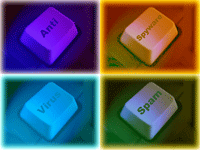8 in 10 home wireless users have little or no wireless security protection
 Did you know that almost 80% of home wireless users have little or no security protection for their wireless networks.
Did you know that almost 80% of home wireless users have little or no security protection for their wireless networks.
Some users lack even basic access protection, which prevents others sharing their Internet connections and therefore ‘freeloading’ off them. This is also exposing them to ‘phishing’ attacks, amongst other things.
Password Protection for Wireless Connections
The first level of protection for your wireless network is a simple password which prevents others from accessing your network. Most wireless hardware manufacturers should allow you access to a control panel which enables you to password protect your network. If you are not sure how to set your network password, contact your broadband provider, look in your wireless router handbook or alternatively search online for information from your specific vendor.
Typical passwords should be easy for you to remember, but hard for others to guess. For example, if you lived at ‘41 Cherry Lane’ your password could be ‘Ila41cl’ which would translate as ‘I live at 41 Cherry Lane’. A combination of letters and numbers is always harder to guess.
WEP or WPA?
Since hackers have now provided tools to crack the old WEP (Wired Equivalent Privacy) standard, it is much safer if you can upgrade to the new WPA (Wifi Protected Access) standard, or WPA2.
However, upgrading from WEP to WPA may not be possible if you have an old router or a slow computer. The new WPA or WPA2 standard requires more processing power to perform, therefore you may experience a slight slow down in your computers performance depending on its processing power.
SSID (Service Set Identifier)
For added wireless network security you can also change your SSID (network name) or prevent it being broadcast altogether. Most people never change their network name, which is often defaulted to their router manufacturer such as ‘Belkin’.
Hackers can recognise this and specifically target these networks as they highlight the inexperience of users.
If you stop the broadcast of you SSID this makes your network much harder to find and therefore much more difficult to hack. More experienced users will attempt to hide the broadcast of their SSID.
Security Software
Having firewall, anti-virus, anti-phishing and anti-spyware software can also improve the security of your wireless network. It is necessary to keep this software up-to-date to prevent any new holes appearing in you wireless security.
It is also a good idea to make sure you have Windows Update turned on to prevent any security breaches within Windows and Internet Explorer compromising the integrity of your wireless network.
Further Wireless Security Information
The Wifi Alliance
The Wifi Alliance is the organisation which lays down the standards for wireless communication networks. For beginners and experts alike the Wifi Alliance is a good port of call to get information on setting up a wireless network.
